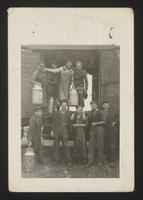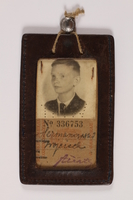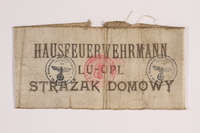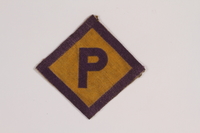Overview
- Brief Narrative
- Envelope fragment with two stamps issued in 1943 by the Polish government-in-exile, while based in London, England, and acquired by Wojciech Hermanowski. These are two of the eight second-issue stamps, which were only valid in friendly and neutral nations, such as Great Britain. The stamps helped raise money for the Ministry of Finance, and were used as propaganda to remind the public that the Polish military was still fighting, even while their territory was occupied by Germany. Wojciech was a Roman Catholic boy living with his parents, Jan and Stanislawa, and his older brother, Andrzej, in Warsaw, Poland, when the German army invaded on September 1, 1939. Wojciech was no longer allowed to go to school, so he began attending trade school and took general classes in secret. In February 1943, Andrzej was arrested as part of the underground resistance, and later transported to Auschwitz concentration camp. On August 1, 1944, the city’s underground resistance rose up against the German occupation forces. During the Warsaw Uprising, Wojciech and his parents were deported to a slave labor camp in Wriezen, Germany. Wojciech was then transferred to work at a dairy processing facility in nearby Eberswalde, and later reunited with his parents. From April 23 to May 3, 1945, they were sent on a forced march and then abandoned by the German guards. The family was found by Allied soldiers and were taken to a camp for displaced persons in Lübeck. They were reunited with Andrzej, who was severely ill from imprisonment in Auschwitz, Neungamme, Branschweig and Bergen-Belsen concentration camps. The entire family was transferred to Sweden for recuperation in July 1945, where Wojciech changed his name to Richard. Richard’s parents and brother decided to return to Poland early in 1947. Richard immigrated to the United States in 1954, settling in New York City.
- Date
-
commemoration:
1940 May
issue: 1943 September 01
- Geography
-
issue:
London (England),
- Credit Line
- United States Holocaust Memorial Museum Collection, Gift of Wojciech Hermanowski
- Markings
- left stamp, top, printed, white : WOJSKO POLSKIE W NORWEGII. / NARVIK - KWIECIEN/MAJ 1940. [POLISH ARMY IN NORWAY. / NARVIK - APRIL/MAY 1940.]
left stamp, bottom, printed, white : POCZTA POLSKA [POLISH POST]
left stamp, bottom right corner, printed, dark blue ink : Gr 55 [55 grosz]
right stamp, top, printed, white : POLSKA MARYNARKA HANDLOWA [POLISH COMMERCIAL NAVY]
right stamp, bottom, printed, white : POCZTA POLSKA [POLISH POST]
right stamp, bottom right corner, printed, dark green ink : Gr 10 [10 grosz] - Contributor
-
Subject:
Richard Wojciech Hermanowski
Issuer: Rzad Rzeczypospolitej Polskiej na uchod?stwie
- Biography
-
Wojciech Hermanowski (later, Richard, b. 1929) was born in Warsaw, Poland, to Jan (1899-1967) and Stanislawa (nee Laszez,1901-1969) Hermanowski. He had one older brother, Andrzej (1924-1992). Wojciech’s father, Jan, worked for the city government as a director of supplies and ran a union for the transportation department. Jan had been in the military police during World War I (1914-1918), and as a result, was a strict disciplinarian. Although Wojciech’s parents identified as Catholic, they were not very religious. The family lived in a city apartment in a nice area of town, and the boys attended the local public school. They were not wealthy, but were able to hire household help, and spent summers at a villa in the countryside.
Wojciech was at the countryside villa with his mother and brother when Germany invaded western Poland on September 1, 1939. They could hear bombs being dropped, and decided to return to the city to join Jan. The German army occupied Warsaw on September 27. German occupation authorities prohibited Poles from attending high school and pursuing higher education, so Wojciech began attending trade school to become a shoemaker’s apprentice, and continued his general education on the side. He also began taking classes in Latin, Polish, and English with a small group of other students. The classes had to move from home to home and were conducted in secret to avoid detection by the German occupation authorities. Andrzej also continued high school lessons with members of the Polish underground, which drew him into the ranks of the resistance fighters.
Jan worked in the transportation department until the summer of 1942, when German authorities became suspicious of his union activities. His bosses were forced to fire him, but offered him a summertime position supervising the excavation of soft coal outside of the city. Jan readily accepted, and the family moved to the countryside for the summer. He was put in charge of 30 Jewish men brought from other towns. On a day when Jan was in the city, a group of Germans went to his worksite, ordered the men to dig a large pit, and shot them all.
In February 1943, Wojciech’s brother was arrested by the German Gestapo as part of the underground resistance. He was held in a jail inside the Warsaw ghetto, which had been established in the fall of 1940. Andrzej was still imprisoned in April, when Schutzstaffel (SS) forces began liquidating the ghetto. From April 19 to May 16, ghetto residents organized a resistance and fought back against the authorities. The uprising was unsuccessful, and thousands of ghetto prisoners, including Andrzej, were deported in retribution to concentration and labor camps.
After the Warsaw Ghetto Uprising, the underground fighters approached Wojciech about working for them, which he declined. Wojciech worked as a firefighter, which allowed him to go out on the streets, even after curfew. On August 1, 1944, another uprising in Warsaw began, this time by the Polish Home Army, outside of the ghetto. Wojciech and a small group of other young neighbors banded together to provide resistance of their own. On the seventh day of the uprising, their building was attacked, and three people were shot in the yard. The German authorities emptied out the building and force marched the residents through the city to a collection area. They put the men through a selection process, and then loaded everyone else onto cattle cars. Their train headed for Auschwitz, but was redirected to Germany. Wojciech and his parents were taken to a sugar-refining factory in Wriezen, where they worked as forced laborers.
Wojciech was then transferred to a dairy processing facility in nearby Eberswalde. His group of forced laborers had to carry 30-liter cans of milk from the trains to the processing facility. In return for this hard work, they were given some extra rations, and they occasionally snuck some milk or cream back to their barracks. After the sugar-refining season was completed, his parents were transferred to Eberswalde as well, and housed together in a different area from Wojciech. He visited them once a week and supplied them with what he could. In 1945, Wojciech came down with dysentery after drinking raw milk, and was sick for six weeks. In April, he was visiting his parents when the approaching Soviet army led the German guards to evacuate the facility. From April 23 to May 3, they were sent on a forced march, during which the guards would occasionally shoot some of the prisoners. One day, the guards disappeared. Although many of the prisoners ran off, Wojciech and his parents continued heading west, away from the Soviets. As they were walking along a crowded road, a German motorcycle hit Jan and Stanislawa, throwing them into a ditch. Although Stanislawa was injured, they continued walking until her infected wounds caused her to collapse in front of a farm.
On May 3, Wojciech and his parents were found by American and British soldiers and taken to the nearby town of Schwerin. A few days later, they were taken to a camp set up for displaced persons in Lübeck. Jan was asked to establish an office to register and organize the Polish refugees. Wojciech got a pass from the British office so that he could go into the town and work. A Polish school opened up in the camp, but Wojciech only attended for a week. The family soon learned that Andrzej was alive in Hamburg. The Polish army sent Jan there, escorted by a couple of soldiers, and brought Andrzej back to the camp.
Andrzej was taken from the prison in the Warsaw Ghetto to Auschwitz concentration camp, where he was assigned prisoner number 121682. After a year, he was transferred to Neuengamme and assigned number 23049, and then to Braunschweig. He was liberated from Bergen-Belsen concentration camp by the American army on April 15, 1945. While in the displaced persons camp, Andrzej was diagnosed with pneumonia, and had previously contracted tuberculosis as well. To get him proper treatment, the Red Cross evacuated the whole family to Malmö, Sweden on July 16, 1945.
After a couple weeks, Wojciech and his parents were moved to a rural village, while Andrzej was placed in a facility near Stockholm to treat his lung problems. Jan was assigned a job creating rags out of old clothing. Wojciech attended a Polish school to complete his education, and later attended a two-year technical school to become a draftsman.
In 1946, Wojciech moved to Stockholm, but his parents and brother decided to return to Poland early in 1947. Wojciech periodically sent packages to his parents, who lived in a ravaged area. During his time in Sweden, Wojciech was confirmed by a bishop, and changed his name to Richard, in honor of a cousin who died in the Warsaw Uprising.
Richard married a survivor from Auschwitz, and they immigrated to the United States in August 1954. The couple separated soon after arriving in New York City. As an immigrant, Richard had difficulty getting a job, but he was able to string together a few short-term positions. He also attended English classes at City college. In 1958, Richard married Mary Shrier (formerly Szrajer, 1931-2014). Mary lived through the Warsaw Uprising, immigrated to Sweden with her parents in 1946, and immigrated to the United States in 1951. Richard and Mary raised their two children in New York City. Richard’s parents and brother remained in Warsaw.
Rząd Rzeczypospolitej Polskiej na uchodźstwie (Government of the Republic of Poland in Exile) was established after Germany and the Soviet Union occupied Poland in September 1939. The Polish government-in-exile was first based in Paris, but moved to London after the French army surrendered to the Germans in the mid-1940s. The Allied powers accepted the government-in-exile as the legitimate representative of the Polish people soon after it was created. The Polish government allied itself with the Allied powers, as its members believed that only a total military victory over Germany would restore Poland's independence and freedom. The government-in-exile led the Polish war effort throughout World War II, and amassed its own land, air, and naval forces. In addition, it commanded the largest underground army of the war, the Armia Krajowa (the Polish Home Army). In 1942, reports about the mass murder of Jews in Poland reached London. At that point, the Polish government-in-exile made several public declarations on the subject, and officially demanded that the Allied powers stop the Germans from continuing their campaign to murder Jews, and other individuals they deemed undesirable. From December 1942 onward, the government-in-exile backed the rescue work of Zegota, which offered aid to Jews throughout occupied Poland.
Physical Details
- Language
- Polish
- Classification
-
Exchange Media
- Category
-
Postage stamps
- Object Type
-
Postage stamps (lcsh)
- Genre/Form
- Postage stamps.
- Physical Description
- Two postage stamps adhered to a small rectangle of cream-colored paper with three torn edges and an unevenly cut bottom edge. On the left, the vertically-oriented stamp has a blue-printed scene of two soldiers in field uniforms perched on a rocky hillside. One of the soldiers is leaning over the edge, looking at a body of water with a warship in the distance; the other is crouched down, talking on a field phone. Across the top and bottom are dark blue bands with white Polish text. In the bottom right corner of the stamp is a white box containing dark blue text. On the right, the horizontally-oriented stamp has a green-printed scene of two men on the prow of a ship flying a Polish flag. One man is holding binoculars and pointing at a plane in the sky. The second man is crouched behind a machine gun, aimed up at the plane. In the distance, a warship is sailing in their direction. Across the top and bottom are dark green borders with white Polish text. The green stamp overlays a handwritten pencil inscription. Overlaying the bottom halves of the stamps is a cancellation mark, hand stamped in black ink.
- Dimensions
- overall: Height: 1.500 inches (3.81 cm) | Width: 4.000 inches (10.16 cm)
- Materials
- overall : paper, ink, adhesive, pencil
- Inscription
- front, right side, handwritten, pencil : [illegible]
front, stamped, black ink : POLSKA MARYNARKA / WOJENNA [POLISH NAVY]
Rights & Restrictions
- Conditions on Access
- No restrictions on access
- Conditions on Use
- No restrictions on use
Keywords & Subjects
- Topical Term
- Christians--Poland. Families. Forced labor--Germany. Labor camps--Germany. Warsaw (Poland)--History--Uprising, 1944. World War, 1939-1945--Children--Poland. World War, 1939-1945--Deportations from Poland. World War, 1939-1945--Underground movements--Personal narratives. Commemorative postage stamps.
Administrative Notes
- Legal Status
- Permanent Collection
- Provenance
- The envelope fragment and stamps were donated to the United States Holocaust Memorial Museum in 2014 by Richard Wojciech Hermanowski.
- Record last modified:
- 2023-06-02 07:45:56
- This page:
- https://collections.ushmm.org/search/catalog/irn106729
Download & Licensing
In-Person Research
- By Appointment
- Request 21 Days in Advance of Visit
- Plan a Research Visit
- Request to See This Object
Contact Us
Also in Hermanowski family collection
The collection consists of an armband, a badge, an envelope with commemorative stamps, documents, and photographs relating to the experiences of Wojciech Hermanowksi and his family in Poland, Germany, and Sweden during and after the Holocaust.
Date: approximately 1935-approximately 1946

Hermanowski family papers
Document
The papers consist of documents and photographs relating to the Hermanowski family of Warsaw. Includes Wojciech Hermanowksi's documents referring to his education and slave labor; family photographs, including among them a photograph depicting Wojciech working in a dairy; documents relating to the family's post-war status as displaced persons; and Swedish passport for foreigners.

Public transport pass and identification tag issued to a Roman Catholic Polish youth
Object
Leather tag with an identification card and public transport pass for July 1944, issued to Wojciech Hermanowski. Wojciech was a Roman Catholic boy living with his parents, Jan and Stanislawa, and his older brother, Andrzej, in Warsaw, Poland, when the German army invaded on September 1, 1939. Wojciech was no longer allowed to go to school, so he began attending trade school and took general classes in secret. In February 1943, Andrzej was arrested as part of the underground resistance, and later transported to Auschwitz concentration camp. On August 1, 1944, the city’s underground resistance rose up against the German occupation forces. During the Warsaw Uprising, Wojciech and his parents were deported to a slave labor camp in Wriezen, Germany. Wojciech was then transferred to work at a dairy processing facility in nearby Eberswalde, and later reunited with his parents. From April 23 to May 3, 1945, they were sent on a forced march and then abandoned by the German guards. The family was found by Allied soldiers and were taken to a camp for displaced persons in Lübeck. They were reunited with Andrzej, who was severely ill from imprisonment in Auschwitz, Neungamme, Branschweig and Bergen-Belsen concentration camps. The entire family was transferred to Sweden for recuperation in July 1945, where Wojciech changed his name to Richard. Richard’s parents and brother decided to return to Poland early in 1947. Richard immigrated to the United States in 1954, settling in New York City.

White cloth armband worn by a Roman Catholic Polish firefighter in Warsaw
Object
Firefighter’s armband issued to Wojciech Hermanowski and used during the German occupation of Warsaw. The armband enabled Wojciech to safely go out on the streets, even after curfew, which was dangerous for most Polish residents. Wojciech was a Roman Catholic boy living with his parents, Jan and Stanislawa, and his older brother, Andrzej, in Warsaw, Poland, when the German army invaded on September 1, 1939. Wojciech was no longer allowed to go to school, so he began attending trade school and took general classes in secret. In February 1943, Andrzej was arrested as part of the underground resistance, and later transported to Auschwitz concentration camp. On August 1, 1944, the city’s underground resistance rose up against the German occupation forces. During the Warsaw Uprising, Wojciech and his parents were deported to a slave labor camp in Wriezen, Germany. Wojciech was then transferred to work at a dairy processing facility in nearby Eberswalde, and later reunited with his parents. From April 23 to May 3, 1945, they were sent on a forced march and then abandoned by the German guards. The family was found by Allied soldiers and were taken to a camp for displaced persons in Lübeck. They were reunited with Andrzej, who was severely ill from imprisonment in Auschwitz, Neungamme, Branschweig and Bergen-Belsen concentration camps. The entire family was transferred to Sweden for recuperation in July 1945, where Wojciech changed his name to Richard. Richard’s parents and brother decided to return to Poland early in 1947. Richard immigrated to the United States in 1954, settling in New York City.

Forced labor badge worn by a Roman Catholic Polish youth
Object
Forced labor badge worn by Wojciech Hermanowski, to identify him as a Polish forced laborer in Wriezen and Eberswalde, Germany, near Breslau, between August 1944 and May 1945. Wojciech was a Roman Catholic boy living with his parents, Jan and Stanislawa, and his older brother, Andrzej, in Warsaw, Poland, when the German army invaded on September 1, 1939. Wojciech was no longer allowed to go to school, so he began attending trade school and took general classes in secret. In February 1943, Andrzej was arrested as part of the underground resistance, and later transported to Auschwitz concentration camp. On August 1, 1944, the city’s underground resistance rose up against the German occupation forces. During the Warsaw Uprising, Wojciech and his parents were deported to a slave labor camp in Wriezen, Germany. Wojciech was then transferred to work at a dairy processing facility in nearby Eberswalde, and later reunited with his parents. From April 23 to May 3, 1945, they were sent on a forced march and then abandoned by the German guards. The family was found by Allied soldiers and were taken to a camp for displaced persons in Lübeck. They were reunited with Andrzej, who was severely ill from imprisonment in Auschwitz, Neungamme, Branschweig and Bergen-Belsen concentration camps. The entire family was transferred to Sweden for recuperation in July 1945, where Wojciech changed his name to Richard. Richard’s parents and brother decided to return to Poland early in 1947. Richard immigrated to the United States in 1954, settling in New York City.



